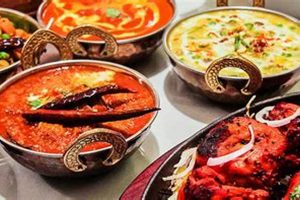Cuisine originating from the Indian subcontinent can adhere to Jewish dietary laws. This involves ensuring that ingredients and preparation methods comply with the principles of kashrut. For example, a lentil soup prepared without meat products, dairy ingredients, or non-kosher certified additives, and cooked in a kitchen following kosher guidelines, would be considered compliant.
Adhering to these standards allows individuals who observe Jewish dietary laws to enjoy the diverse flavors and culinary traditions of the Indian subcontinent. Historically, Jewish communities in India adapted local dishes to conform to their religious requirements. This practice fostered a unique fusion of culinary traditions, allowing for cultural exchange and the preservation of dietary practices.
The following sections will explore the specific considerations, common ingredients, and potential challenges involved in preparing meals, the availability of certified products, and resources for individuals seeking to maintain adherence to religious dietary requirements while enjoying the cuisine.
Guidance for Observing Dietary Laws within Subcontinental Cuisine
The following suggestions provide clarity on navigating the intersection of culinary traditions and adherence to specified dietary guidelines.
Tip 1: Ingredient Verification: All ingredients, including spices, must possess kosher certification. Scrutinize labels meticulously for reliable symbols of approval. This ensures compliance throughout the cooking process.
Tip 2: Utensil Segregation: Maintain distinct sets of cookware and serving utensils for meat and dairy preparations. This prevents cross-contamination and upholds the separation mandated by religious law.
Tip 3: Meat and Dairy Separation: Strictly avoid combining meat and dairy products in any preparation. Many subcontinental dishes traditionally include dairy; modifications may be required to ensure compliance.
Tip 4: Produce Inspection: Thoroughly inspect all produce for insects before use. Certain insects are prohibited under dietary laws; meticulous examination is essential.
Tip 5: Cross-Contamination Prevention: Exercise caution when consuming food prepared in a facility that also handles non-kosher items. Cross-contamination can compromise the integrity of otherwise permissible dishes.
Tip 6: Understanding Regional Variations: Be aware that different regional variations within the cuisine may present unique challenges or require specific adjustments to meet dietary requirements.
Adhering to these considerations enables individuals to experience the richness of flavor while upholding their religious commitments.
The concluding section will address resources and further guidance for maintaining these practices consistently.
1. Ingredient Certification
Ingredient certification forms a foundational pillar in adhering to Jewish dietary laws when preparing and consuming foods originating from the Indian subcontinent. Given the complexity and variety of ingredients used, verification is crucial to ensure compliance with kashrut.
- Reliable Symbol Verification
Certification symbols issued by recognized kosher certifying agencies provide assurance that ingredients meet specific standards. These symbols, displayed on product packaging, indicate that a rabbinical authority has inspected the production process and deemed it compliant. Without these symbols, the kosher status of an ingredient remains uncertain.
- Spice and Seasoning Scrutiny
Spices and seasonings, commonly used in Indian cuisine, require careful scrutiny. These products may contain additives or undergo processing methods that render them non-kosher. Certification verifies the absence of prohibited substances and adherence to proper handling procedures throughout the supply chain.
- Oil and Fat Assessment
Oils and fats, essential components in many Indian dishes, must be derived from kosher sources. Animal-based fats are generally prohibited, and vegetable oils require certification to confirm they have not been processed using non-kosher equipment or mixed with non-kosher additives.
- Processed Food Oversight
Processed food items, such as lentils, flours, and sauces, necessitate certification to confirm their kosher status. The processing methods used in the manufacturing of these products can introduce non-kosher ingredients or contaminants, making certification essential for adherence to dietary laws.
The thorough application of ingredient certification practices is thus integral to the preparation of compliant food. The meticulous verification of each component reinforces the commitment to maintaining dietary standards while enjoying the flavors inherent to the cuisine. Consistent attentiveness to these practices is imperative for individuals who adhere to Jewish dietary requirements and wish to partake in this diverse culinary tradition.
2. Utensil Separation
Utensil separation is a critical component in maintaining the adherence to Jewish dietary laws when preparing cuisine from the Indian subcontinent. The principle of kashrut dictates a strict separation between meat and dairy. This necessitates the use of distinct sets of utensils, cookware, and serving dishes for each category. Failure to maintain this separation renders the food non-kosher due to cross-contamination.
The rationale for utensil separation lies in preventing the mingling of substances that are considered forbidden under religious law. Even trace amounts of meat or dairy residue on cooking surfaces or utensils can compromise the kosher status of a dish. For example, using a spoon that previously stirred a dairy-based curry to serve a meat-based biryani would violate this principle. Similarly, frying vegetables in a pan used to cook meat products is prohibited. This rigorous separation requires diligent management of kitchen tools and appliances, often necessitating designated storage areas and color-coding systems to prevent accidental mixing.
The practical significance of understanding utensil separation is substantial for individuals seeking to prepare and consume cuisine while upholding their religious commitments. Without adhering to this principle, even dishes prepared with certified ingredients would not be considered kosher. Therefore, the commitment to maintaining separate utensils, cookware, and serving dishes is paramount. This practice directly affects the acceptability of the food and its alignment with specific dietary observances.
3. Meat-Dairy Prohibition
The prohibition against consuming meat and dairy together is a cornerstone of kashrut and a significant consideration when adapting cuisine from the Indian subcontinent for kosher observance. This prohibition, rooted in religious law, necessitates that dishes containing meat are prepared, cooked, and consumed separately from those containing dairy. The effect of this regulation on adapts from the Indian subcontinent is profound, as many traditional recipes incorporate both meat and dairy ingredients. The consequence is that authentic recipes often require significant modification to comply with kosher standards. The importance of this prohibition lies in its central role within religious dietary framework and dictates all dietary planning.
For example, a common dish from India, butter chicken, is inherently non-kosher due to the combination of chicken (meat) and butter and cream (dairy). A kosher adaptation would require the use of non-dairy substitutes, such as coconut cream or nut-based cream alternatives, to replace the dairy components. Similarly, a lamb curry simmered in yogurt would need to be reformulated with plant-based yogurt alternatives. The practical application extends beyond recipe modification to kitchen practices, where separate cookware, utensils, and serving dishes must be maintained to prevent cross-contamination. This separation ensures that no meat residue comes into contact with dairy products, upholding the integrity of the kosher status.
In summary, the meat-dairy prohibition presents a considerable challenge and necessitates creative solutions for the cuisine. Navigating these restrictions requires a deep understanding of both culinary traditions and religious mandates. The effort to adapt Indian cuisine for kosher observance underscores the commitment to maintaining dietary laws while partaking in diverse culinary experiences. However, ingredient alternatives and careful kitchen practices are vital to success.
4. Produce Inspection
The meticulous inspection of produce is a fundamental aspect of adhering to Jewish dietary laws within the context of cuisine originating from the Indian subcontinent. Given the agricultural practices and environmental conditions in the region, produce is particularly susceptible to insect infestation, which poses a significant challenge to maintaining kashrut.
- Prohibition of Insects
Jewish dietary laws prohibit the consumption of insects. Produce, especially leafy greens and vegetables grown close to the ground, must be thoroughly inspected for any insect presence. The implication for cuisine is that raw and cooked vegetable dishes require diligent examination before preparation and consumption.
- Washing and Visual Inspection
The inspection process typically involves washing produce thoroughly to dislodge any insects and conducting a visual inspection under adequate lighting. Specialized tools, such as magnifying glasses and light boxes, may be employed to detect smaller insects that are difficult to see with the naked eye. Certain communities have developed specific techniques and rituals for vegetable cleaning and inspection.
- Specific Produce Challenges
Certain types of produce commonly used in Indian cuisine, such as spinach, cilantro, and cauliflower, are known to be particularly prone to insect infestation. These items require extra attention during inspection. Complex vegetable dishes should be carefully inspected after cooking, due to potential concealment. This may involve specific cutting and cleaning methods for those specific items.
- Impact on Culinary Practices
The requirement for produce inspection can impact culinary practices. It may necessitate changes in preparation methods and ingredient selection. Restaurants catering to observant individuals often employ dedicated staff to inspect produce, ensuring compliance with dietary laws. This demonstrates its critical function and commitment to the process.
In conclusion, the meticulous inspection of produce stands as a key element in maintaining kashrut. This process necessitates adherence to specific protocols and a comprehensive understanding of the types of produce most susceptible to insect infestation. This detailed examination allows individuals to maintain dietary standards while still enjoying the diverse range of vegetarian and vegetable-based dishes common to the cuisine.
5. Cross-Contamination Avoidance
Cross-contamination avoidance is a central tenet in maintaining the integrity when culinary traditions from the Indian subcontinent are adapted to meet Jewish dietary laws. The complexity of and the prevalence of non-kosher ingredients necessitate stringent measures to prevent any unintended mingling that would compromise the kosher status of the food.
- Dedicated Utensil Usage
The segregation of utensils and cookware is paramount to prevent the transfer of non-kosher substances. Designated sets of pots, pans, serving dishes, and cutlery are essential for meat, dairy, and parve (neutral) preparations. For instance, a spoon used in a dairy-based curry should never be used in a meat-based dish. Failure to observe this practice renders the entire dish non-kosher.
- Surface Sanitation Protocols
Countertops, cutting boards, and other food preparation surfaces must be thoroughly cleaned and sanitized between the preparation of different types of dishes. Residual traces of non-kosher ingredients can contaminate subsequent preparations. The use of separate cutting boards for meat, dairy, and produce is recommended. Effective cleaning agents and procedures are vital to eliminate any potential cross-contamination.
- Oven and Cooking Appliance Management
Ovens and other cooking appliances used to prepare both kosher and non-kosher foods require careful management. Ideally, separate ovens should be used. If this is not feasible, the oven must undergo a kosherization process before preparing food. This may involve cleaning, heating, or specific rituals depending on religious requirements. Convection ovens are particularly challenging due to air circulation that can spread contaminants.
- Ingredient Storage and Handling
Proper storage and handling practices are crucial to prevent cross-contamination of ingredients. Non-kosher ingredients must be stored separately from kosher ingredients. Care must be taken to avoid spills or contact between different food items. Clear labeling and organization of storage areas is essential to minimize the risk of accidental contamination.
These considerations underscore the importance of strict adherence to kosher principles when preparing cuisine. The prevention of cross-contamination is not merely a procedural matter; it is fundamental to maintaining the integrity and compliance with the stringent standards of kashrut. Observance of these measures contributes directly to the acceptability of the food in accordance with Jewish dietary requirements.
6. Spice Sourcing
Spice sourcing represents a critical juncture in the preparation, particularly when adhering to Jewish dietary law. Many spices and spice blends can contain additives or may have been processed using equipment that compromises their status. Vigilance at the point of origin, processing, and distribution is necessary to maintain conformity to specific religious dietary laws.
- Certified Kosher Spices
The assurance that spices are manufactured under rabbinical supervision is paramount. Certification symbols, issued by recognized kosher agencies, provide confidence that the spices have not been adulterated with non-kosher ingredients or processed on equipment that violates kashrut. Common examples include cumin, coriander, turmeric, and garam masala. These must possess verifiable kosher certification from a recognized authority.
- Avoiding Cross-Contamination
Even intrinsically kosher spices can become compromised through cross-contamination. If spices are processed or stored in facilities that also handle non-kosher ingredients, they may no longer be acceptable. Reputable spice suppliers ensure dedicated equipment and stringent cleaning protocols to prevent any cross-contamination, preserving the kosher status of their products.
- Hidden Additives and Fillers
Certain spice blends may contain hidden additives, such as anti-caking agents, flavor enhancers, or fillers, which are non-kosher. Maltodextrin, a common filler, may be derived from corn or wheat, and its kosher status requires verification. The purity and composition of spices must be meticulously scrutinized to ensure compliance.
- Organic vs. Kosher Certification
While organic certification addresses environmental concerns, it does not automatically guarantee adherence to Jewish dietary laws. A spice may be organic but still processed on equipment used for non-kosher items. Both organic and kosher certifications offer distinct assurances, and both should be sought when aligning dietary and ethical values.
The deliberate and informed selection of spices impacts more than just the flavor profile; it is central to compliance. The diligent verification of spice sourcing is integral to ensuring that culinary creations align with dietary practices, allowing for the enjoyment of diverse flavors while upholding religious commitments. Consistent attention to detail in sourcing decisions is imperative for both individuals and establishments striving for kosher integrity.
7. Ritual Observance
The intersection of ritual observance and food preparation holds significant weight, particularly when adapting cuisine from the Indian subcontinent to align with Jewish dietary laws. Ritual Observance becomes a critical component in ensuring adherence to religious guidelines and infuses a sense of sanctity into the culinary process.
- Hand Washing (Netilat Yadayim)
The ritual washing of hands before consuming bread is a widespread Jewish practice. In the context of cuisine, this act extends to any meal where bread is a central element. The act of hand washing signifies purification and intention before partaking in the meal, elevating it beyond mere sustenance. Therefore, even with adapted cuisine, this ritual maintains its importance when bread or bread-like products, such as naan or roti, are consumed.
- Blessings (Brachot)
The recitation of blessings before and after meals is a fundamental aspect of Jewish tradition. A specific blessing is said before consuming food, acknowledging its source and expressing gratitude. Another blessing is recited after the meal, thanking the provider of nourishment. Within the framework of Indian-adapted food, these blessings remain unchanged, as they are dependent on the food category (e.g., bread, fruit, vegetables) rather than the cuisine itself. The brachot imbue the eating experience with a sense of mindfulness and spiritual awareness.
- Sabbath and Holiday Observances
The Jewish Sabbath and various holidays are marked by specific dietary restrictions and customs. During Passover, the prohibition of leavened products requires careful consideration in all food preparation. While traditional Indian food is not inherently chametz (leavened), care must be taken to ensure no forbidden ingredients are used. Similarly, other holidays, like Sukkot or Rosh Hashanah, may influence meal planning and the types of dishes served.
- Symbolic Foods
Certain Jewish holidays incorporate symbolic foods that hold specific meanings. For instance, apples and honey are traditionally eaten on Rosh Hashanah to symbolize a sweet new year. While these foods are not unique to a particular cuisine, they can be incorporated into Indian-adapted meal preparations to add a cultural and symbolic dimension to the holiday observance. Finding ways to integrate such traditional foods into the cuisine helps maintain the cultural through-line.
The incorporation of ritual observance into food preparation represents a holistic approach to eating. It is essential to adhere to religious guidelines and imbues the culinary experience with meaning and spiritual significance. As the cuisine is adapted, the continuation of these ritual practices maintains a connection to religious tradition, enriching the dining experience and enhancing its significance beyond simple nourishment.
Frequently Asked Questions
The following section addresses prevalent inquiries regarding the preparation and consumption, offering clarification on key considerations and common misconceptions.
Question 1: Are all restaurants self-described as serving food reliably compliant?
No. The assertion of adherence to Jewish dietary law requires independent verification. A restaurant must possess certification from a recognized kosher certifying agency to ensure compliance.
Question 2: Is it permissible to use utensils interchangeably between meat and dairy dishes if they have been thoroughly washed?
No. Utensils used for meat preparation must remain separate from those used for dairy. Washing does not remove the absorbed flavor and renders the utensil non-kosher for the opposing food category.
Question 3: Can any type of oil be used in the preparation of dishes?
No. Only oils that possess certification are permissible. Vegetable oils must be processed using kosher-certified equipment to ensure they have not come into contact with non-kosher substances.
Question 4: Does organic certification automatically guarantee compliance?
No. While organic certification addresses agricultural practices, it does not ensure adherence to Jewish dietary laws. Independent is required to confirm the absence of non-kosher ingredients and processes.
Question 5: Is it acceptable to consume food prepared in a kitchen that also handles non-kosher items, provided strict separation is maintained?
This practice is generally discouraged. Even with strict separation, the risk of cross-contamination exists. The ideal scenario involves a kitchen exclusively dedicated to kosher food preparation.
Question 6: Are all spices inherently compliant?
No. Spices may contain hidden additives or undergo processing methods that render them non-compliant. Certification is necessary to verify their status.
In summary, understanding and adherence to these guidelines facilitates informed choices and mitigates the risk of inadvertently violating the laws. Rigorous scrutiny and reliable certification are paramount.
The subsequent segment will delve into resources available for locating compliant establishments and ingredients.
Indian Food Kosher
The preceding exploration has illuminated the complexities involved in adapting dishes from the Indian subcontinent to meet the stringent requirements. This involves meticulous attention to ingredient sourcing, utensil separation, the meat-dairy prohibition, produce inspection, cross-contamination avoidance, spice verification, and ritual observance. Each of these facets demands careful consideration and adherence to established kosher principles.
Maintaining kosher standards within the context of cuisine requires ongoing vigilance and a commitment to rigorous practices. Individuals and establishments seeking to uphold these standards must prioritize ingredient certification, implement stringent kitchen protocols, and remain informed about evolving dietary regulations. The pursuit of adherence not only satisfies religious obligations but also exemplifies a dedication to integrity and mindful consumption. Continued education and collaboration are crucial in ensuring the accessibility and reliability of options for those who observe these dietary laws.







